Strategic Report: Assessing Backup and Disaster Recovery Planning
VerifiedAdded on 2023/06/14
|9
|1798
|367
Report
AI Summary
This report provides an analysis of backup and disaster recovery plans, emphasizing their critical role in ensuring business continuity. It explores the challenges and solutions associated with data backup and recovery, highlighting the importance of having a well-defined disaster recovery plan to minimize adverse effects caused by interruptions. The report evaluates various businesses' experiences with disaster recovery, including Google's and Microsoft's failures and successes, as well as Amazon's strategies for long-term growth and disaster recovery solutions using Amazon Web Services (AWS). The study uses qualitative data techniques and secondary data analysis to understand the complexities of disaster recovery planning, emphasizing the need for planning, establishing, testing, and implementing effective disaster recovery management procedures. The report also touches on cloud computing as a solution for technological failures, noting that a comprehensive disaster recovery plan is more efficient due to its multi-step approach to countering unforeseen risks. The document concludes by underscoring the significance of AWS in providing flexible and scalable solutions for meeting computing needs and ensuring data protection through cloud backups.

Backup and disaster recovery plan
Student’s name
Institution Affiliations
Student’s name
Institution Affiliations
Paraphrase This Document
Need a fresh take? Get an instant paraphrase of this document with our AI Paraphraser
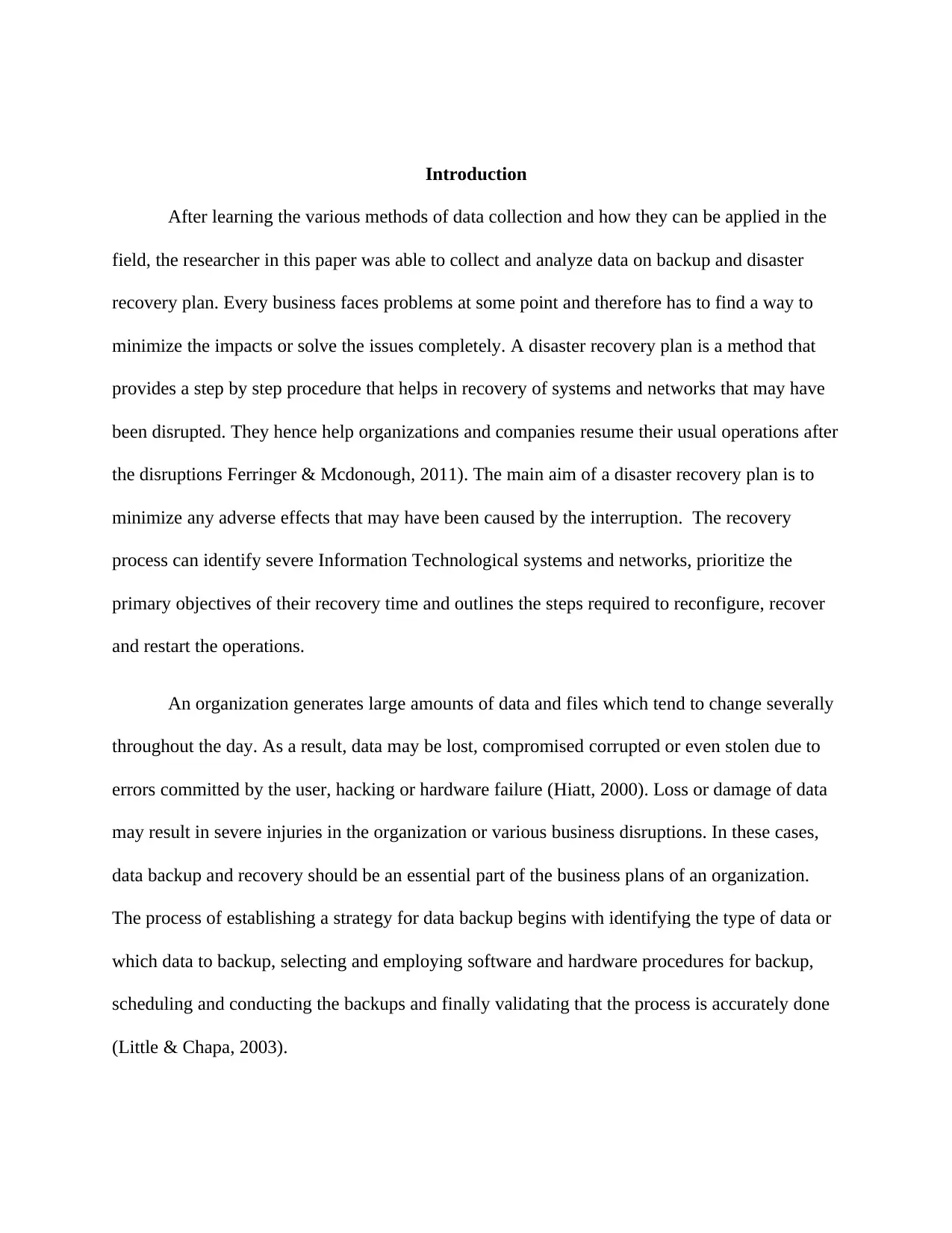
Introduction
After learning the various methods of data collection and how they can be applied in the
field, the researcher in this paper was able to collect and analyze data on backup and disaster
recovery plan. Every business faces problems at some point and therefore has to find a way to
minimize the impacts or solve the issues completely. A disaster recovery plan is a method that
provides a step by step procedure that helps in recovery of systems and networks that may have
been disrupted. They hence help organizations and companies resume their usual operations after
the disruptions Ferringer & Mcdonough, 2011). The main aim of a disaster recovery plan is to
minimize any adverse effects that may have been caused by the interruption. The recovery
process can identify severe Information Technological systems and networks, prioritize the
primary objectives of their recovery time and outlines the steps required to reconfigure, recover
and restart the operations.
An organization generates large amounts of data and files which tend to change severally
throughout the day. As a result, data may be lost, compromised corrupted or even stolen due to
errors committed by the user, hacking or hardware failure (Hiatt, 2000). Loss or damage of data
may result in severe injuries in the organization or various business disruptions. In these cases,
data backup and recovery should be an essential part of the business plans of an organization.
The process of establishing a strategy for data backup begins with identifying the type of data or
which data to backup, selecting and employing software and hardware procedures for backup,
scheduling and conducting the backups and finally validating that the process is accurately done
(Little & Chapa, 2003).
After learning the various methods of data collection and how they can be applied in the
field, the researcher in this paper was able to collect and analyze data on backup and disaster
recovery plan. Every business faces problems at some point and therefore has to find a way to
minimize the impacts or solve the issues completely. A disaster recovery plan is a method that
provides a step by step procedure that helps in recovery of systems and networks that may have
been disrupted. They hence help organizations and companies resume their usual operations after
the disruptions Ferringer & Mcdonough, 2011). The main aim of a disaster recovery plan is to
minimize any adverse effects that may have been caused by the interruption. The recovery
process can identify severe Information Technological systems and networks, prioritize the
primary objectives of their recovery time and outlines the steps required to reconfigure, recover
and restart the operations.
An organization generates large amounts of data and files which tend to change severally
throughout the day. As a result, data may be lost, compromised corrupted or even stolen due to
errors committed by the user, hacking or hardware failure (Hiatt, 2000). Loss or damage of data
may result in severe injuries in the organization or various business disruptions. In these cases,
data backup and recovery should be an essential part of the business plans of an organization.
The process of establishing a strategy for data backup begins with identifying the type of data or
which data to backup, selecting and employing software and hardware procedures for backup,
scheduling and conducting the backups and finally validating that the process is accurately done
(Little & Chapa, 2003).
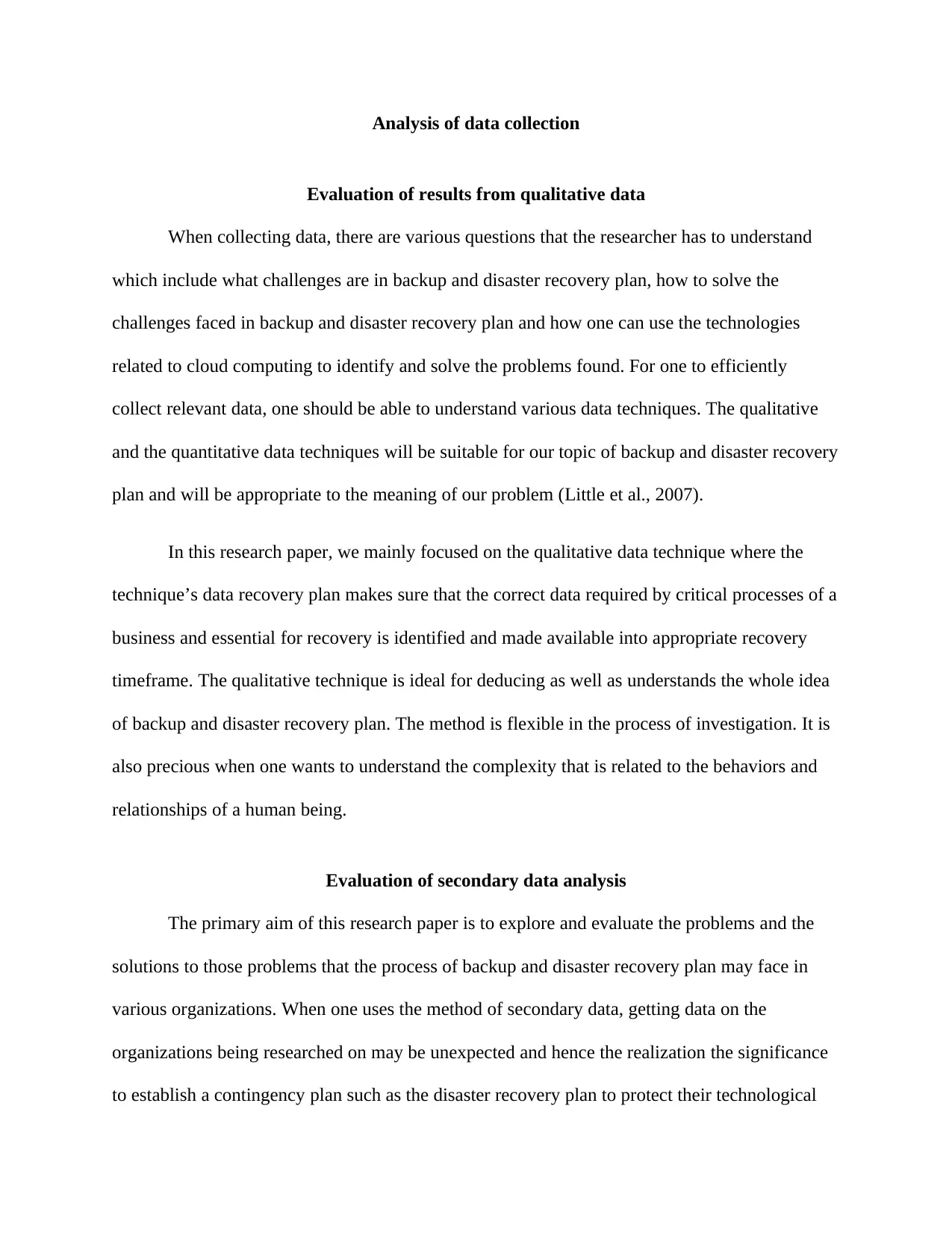
Analysis of data collection
Evaluation of results from qualitative data
When collecting data, there are various questions that the researcher has to understand
which include what challenges are in backup and disaster recovery plan, how to solve the
challenges faced in backup and disaster recovery plan and how one can use the technologies
related to cloud computing to identify and solve the problems found. For one to efficiently
collect relevant data, one should be able to understand various data techniques. The qualitative
and the quantitative data techniques will be suitable for our topic of backup and disaster recovery
plan and will be appropriate to the meaning of our problem (Little et al., 2007).
In this research paper, we mainly focused on the qualitative data technique where the
technique’s data recovery plan makes sure that the correct data required by critical processes of a
business and essential for recovery is identified and made available into appropriate recovery
timeframe. The qualitative technique is ideal for deducing as well as understands the whole idea
of backup and disaster recovery plan. The method is flexible in the process of investigation. It is
also precious when one wants to understand the complexity that is related to the behaviors and
relationships of a human being.
Evaluation of secondary data analysis
The primary aim of this research paper is to explore and evaluate the problems and the
solutions to those problems that the process of backup and disaster recovery plan may face in
various organizations. When one uses the method of secondary data, getting data on the
organizations being researched on may be unexpected and hence the realization the significance
to establish a contingency plan such as the disaster recovery plan to protect their technological
Evaluation of results from qualitative data
When collecting data, there are various questions that the researcher has to understand
which include what challenges are in backup and disaster recovery plan, how to solve the
challenges faced in backup and disaster recovery plan and how one can use the technologies
related to cloud computing to identify and solve the problems found. For one to efficiently
collect relevant data, one should be able to understand various data techniques. The qualitative
and the quantitative data techniques will be suitable for our topic of backup and disaster recovery
plan and will be appropriate to the meaning of our problem (Little et al., 2007).
In this research paper, we mainly focused on the qualitative data technique where the
technique’s data recovery plan makes sure that the correct data required by critical processes of a
business and essential for recovery is identified and made available into appropriate recovery
timeframe. The qualitative technique is ideal for deducing as well as understands the whole idea
of backup and disaster recovery plan. The method is flexible in the process of investigation. It is
also precious when one wants to understand the complexity that is related to the behaviors and
relationships of a human being.
Evaluation of secondary data analysis
The primary aim of this research paper is to explore and evaluate the problems and the
solutions to those problems that the process of backup and disaster recovery plan may face in
various organizations. When one uses the method of secondary data, getting data on the
organizations being researched on may be unexpected and hence the realization the significance
to establish a contingency plan such as the disaster recovery plan to protect their technological
⊘ This is a preview!⊘
Do you want full access?
Subscribe today to unlock all pages.

Trusted by 1+ million students worldwide
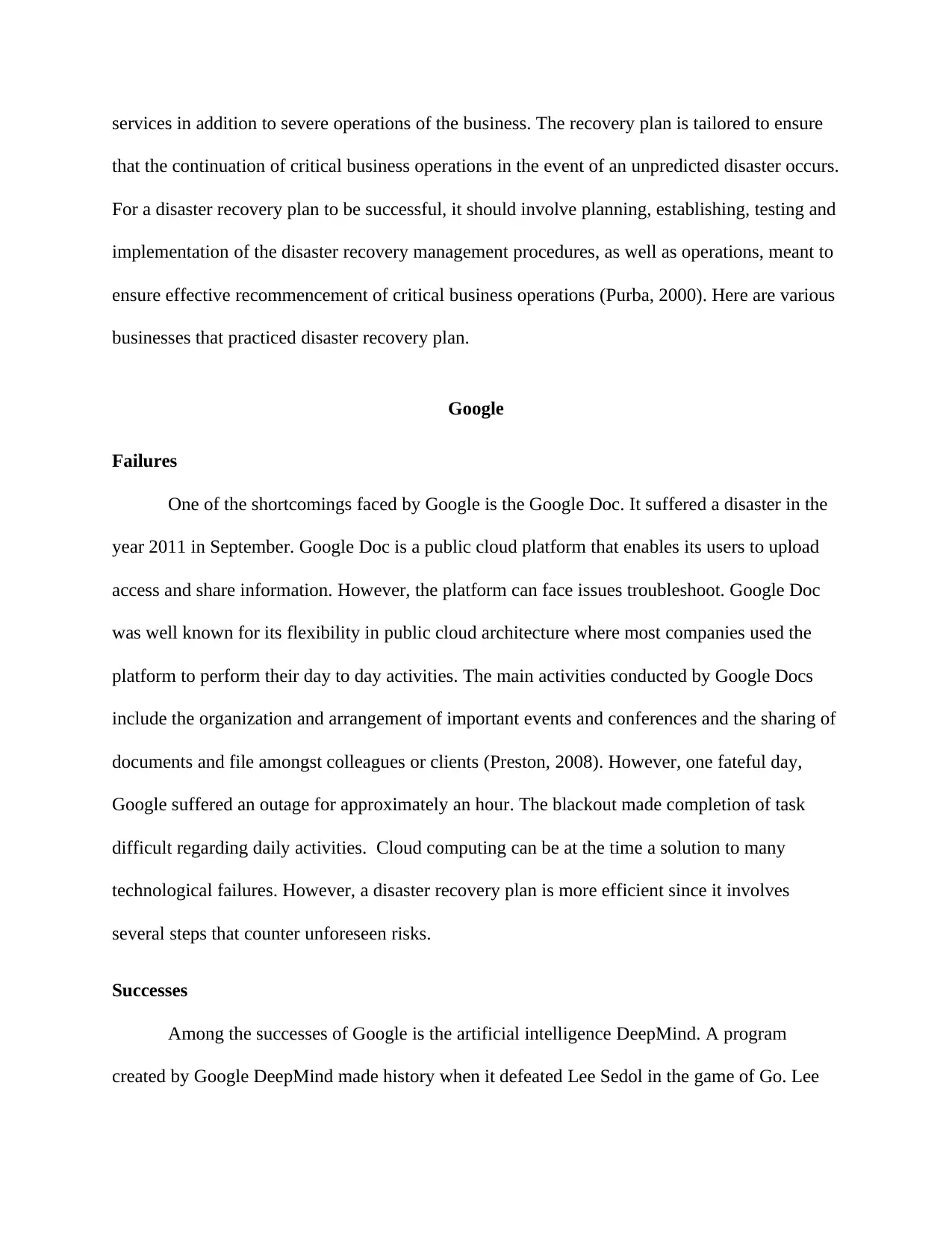
services in addition to severe operations of the business. The recovery plan is tailored to ensure
that the continuation of critical business operations in the event of an unpredicted disaster occurs.
For a disaster recovery plan to be successful, it should involve planning, establishing, testing and
implementation of the disaster recovery management procedures, as well as operations, meant to
ensure effective recommencement of critical business operations (Purba, 2000). Here are various
businesses that practiced disaster recovery plan.
Google
Failures
One of the shortcomings faced by Google is the Google Doc. It suffered a disaster in the
year 2011 in September. Google Doc is a public cloud platform that enables its users to upload
access and share information. However, the platform can face issues troubleshoot. Google Doc
was well known for its flexibility in public cloud architecture where most companies used the
platform to perform their day to day activities. The main activities conducted by Google Docs
include the organization and arrangement of important events and conferences and the sharing of
documents and file amongst colleagues or clients (Preston, 2008). However, one fateful day,
Google suffered an outage for approximately an hour. The blackout made completion of task
difficult regarding daily activities. Cloud computing can be at the time a solution to many
technological failures. However, a disaster recovery plan is more efficient since it involves
several steps that counter unforeseen risks.
Successes
Among the successes of Google is the artificial intelligence DeepMind. A program
created by Google DeepMind made history when it defeated Lee Sedol in the game of Go. Lee
that the continuation of critical business operations in the event of an unpredicted disaster occurs.
For a disaster recovery plan to be successful, it should involve planning, establishing, testing and
implementation of the disaster recovery management procedures, as well as operations, meant to
ensure effective recommencement of critical business operations (Purba, 2000). Here are various
businesses that practiced disaster recovery plan.
Failures
One of the shortcomings faced by Google is the Google Doc. It suffered a disaster in the
year 2011 in September. Google Doc is a public cloud platform that enables its users to upload
access and share information. However, the platform can face issues troubleshoot. Google Doc
was well known for its flexibility in public cloud architecture where most companies used the
platform to perform their day to day activities. The main activities conducted by Google Docs
include the organization and arrangement of important events and conferences and the sharing of
documents and file amongst colleagues or clients (Preston, 2008). However, one fateful day,
Google suffered an outage for approximately an hour. The blackout made completion of task
difficult regarding daily activities. Cloud computing can be at the time a solution to many
technological failures. However, a disaster recovery plan is more efficient since it involves
several steps that counter unforeseen risks.
Successes
Among the successes of Google is the artificial intelligence DeepMind. A program
created by Google DeepMind made history when it defeated Lee Sedol in the game of Go. Lee
Paraphrase This Document
Need a fresh take? Get an instant paraphrase of this document with our AI Paraphraser

Sedol is among the best players of this game. The game involves the arrangement of chips in a
chess oriented way. The game is considered as complex as the mind of a human being.
https://www.cloudwards.net/dropbox-vs-google-drive/
Another success of Google is the facial recognition where in China it has become
common, and citizens are now making payments using facial recognition. They have also created
software for facial recognition where the software can identify and monitor the movements and
activities of its users.
Also, another success of Google is the launch of a rocket into the red planet. The
company made history when it re-launched the Falcon 9 rocket and making it the first time one
single rocket to be reused for several missions.
chess oriented way. The game is considered as complex as the mind of a human being.
https://www.cloudwards.net/dropbox-vs-google-drive/
Another success of Google is the facial recognition where in China it has become
common, and citizens are now making payments using facial recognition. They have also created
software for facial recognition where the software can identify and monitor the movements and
activities of its users.
Also, another success of Google is the launch of a rocket into the red planet. The
company made history when it re-launched the Falcon 9 rocket and making it the first time one
single rocket to be reused for several missions.
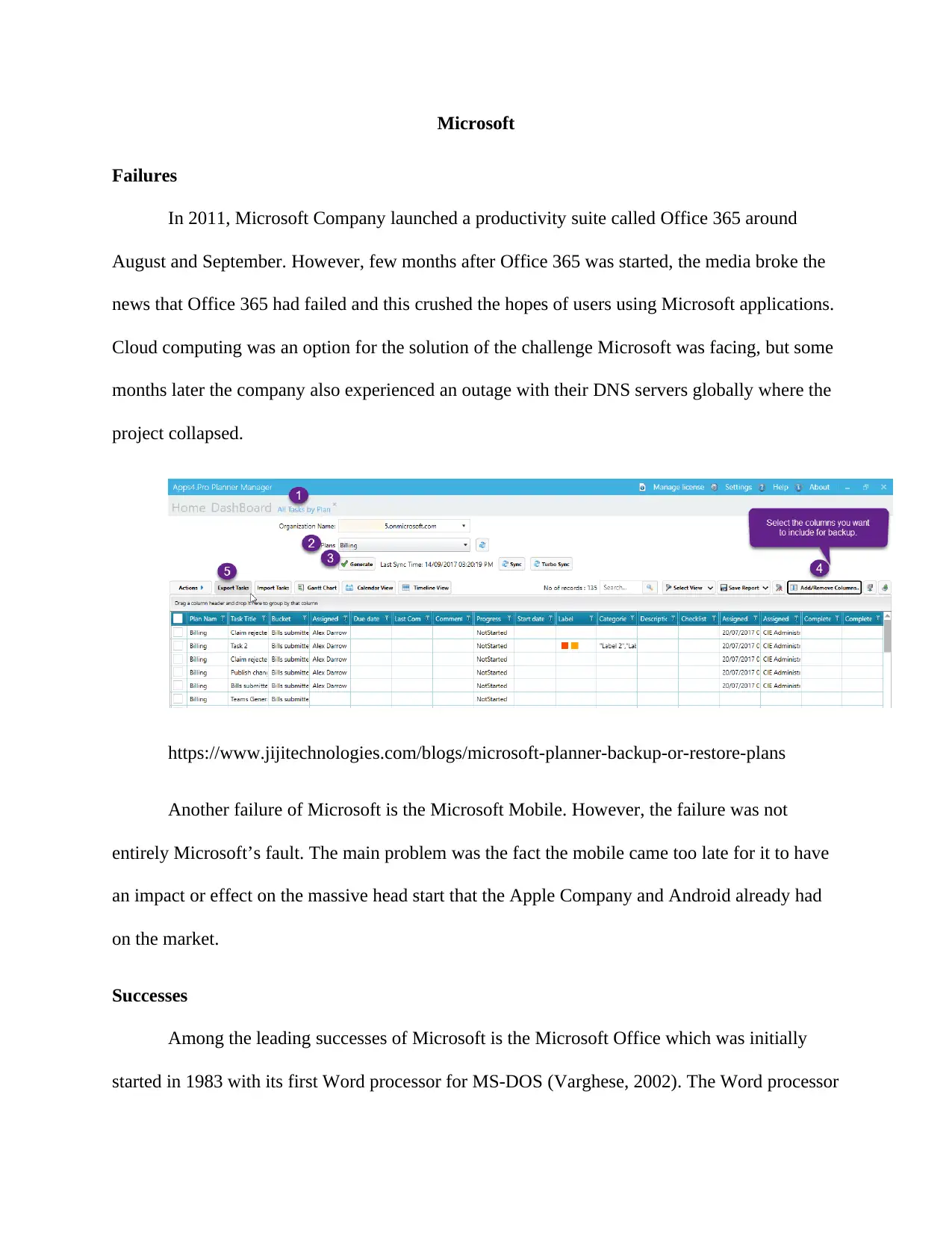
Microsoft
Failures
In 2011, Microsoft Company launched a productivity suite called Office 365 around
August and September. However, few months after Office 365 was started, the media broke the
news that Office 365 had failed and this crushed the hopes of users using Microsoft applications.
Cloud computing was an option for the solution of the challenge Microsoft was facing, but some
months later the company also experienced an outage with their DNS servers globally where the
project collapsed.
https://www.jijitechnologies.com/blogs/microsoft-planner-backup-or-restore-plans
Another failure of Microsoft is the Microsoft Mobile. However, the failure was not
entirely Microsoft’s fault. The main problem was the fact the mobile came too late for it to have
an impact or effect on the massive head start that the Apple Company and Android already had
on the market.
Successes
Among the leading successes of Microsoft is the Microsoft Office which was initially
started in 1983 with its first Word processor for MS-DOS (Varghese, 2002). The Word processor
Failures
In 2011, Microsoft Company launched a productivity suite called Office 365 around
August and September. However, few months after Office 365 was started, the media broke the
news that Office 365 had failed and this crushed the hopes of users using Microsoft applications.
Cloud computing was an option for the solution of the challenge Microsoft was facing, but some
months later the company also experienced an outage with their DNS servers globally where the
project collapsed.
https://www.jijitechnologies.com/blogs/microsoft-planner-backup-or-restore-plans
Another failure of Microsoft is the Microsoft Mobile. However, the failure was not
entirely Microsoft’s fault. The main problem was the fact the mobile came too late for it to have
an impact or effect on the massive head start that the Apple Company and Android already had
on the market.
Successes
Among the leading successes of Microsoft is the Microsoft Office which was initially
started in 1983 with its first Word processor for MS-DOS (Varghese, 2002). The Word processor
⊘ This is a preview!⊘
Do you want full access?
Subscribe today to unlock all pages.

Trusted by 1+ million students worldwide
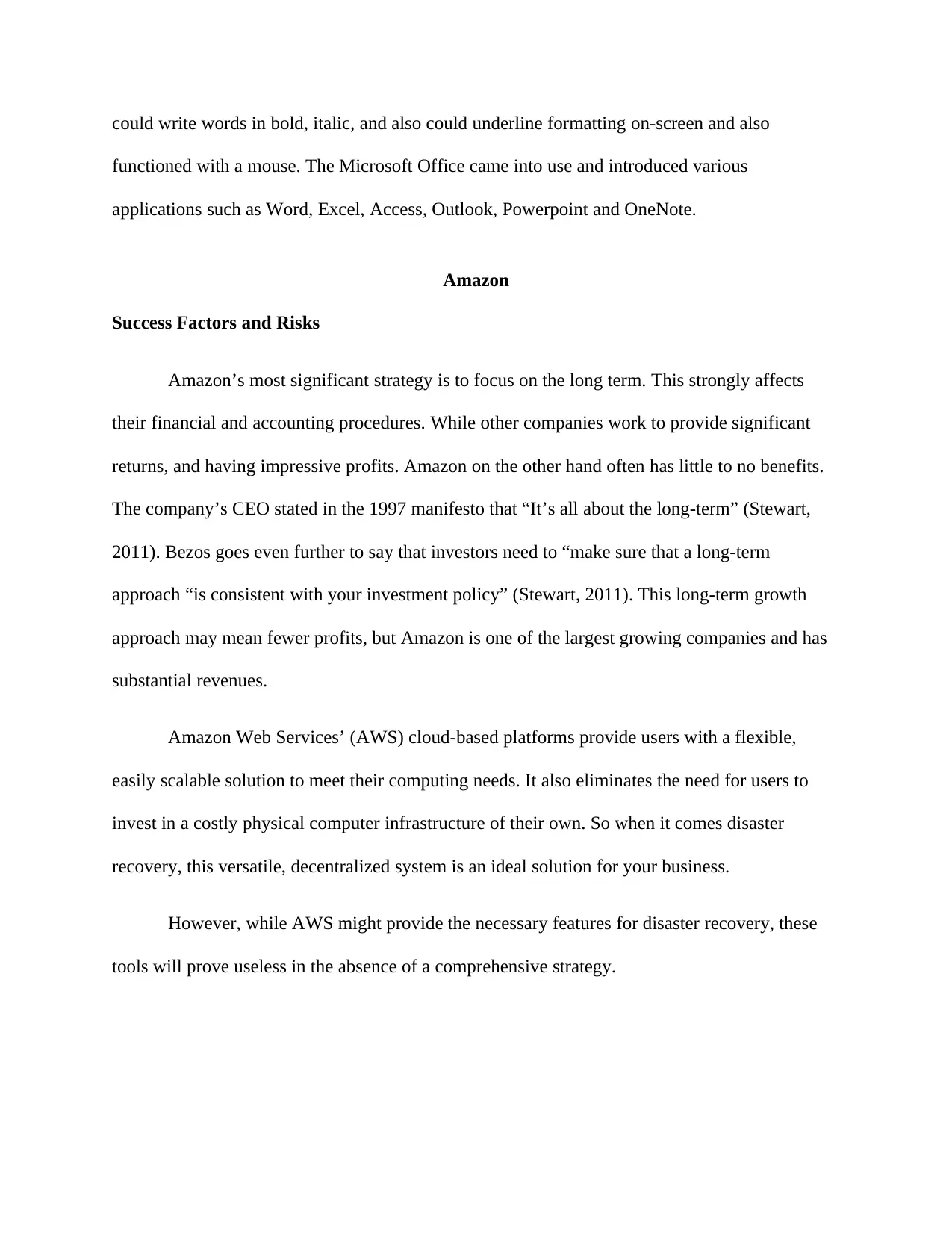
could write words in bold, italic, and also could underline formatting on-screen and also
functioned with a mouse. The Microsoft Office came into use and introduced various
applications such as Word, Excel, Access, Outlook, Powerpoint and OneNote.
Amazon
Success Factors and Risks
Amazon’s most significant strategy is to focus on the long term. This strongly affects
their financial and accounting procedures. While other companies work to provide significant
returns, and having impressive profits. Amazon on the other hand often has little to no benefits.
The company’s CEO stated in the 1997 manifesto that “It’s all about the long-term” (Stewart,
2011). Bezos goes even further to say that investors need to “make sure that a long-term
approach “is consistent with your investment policy” (Stewart, 2011). This long-term growth
approach may mean fewer profits, but Amazon is one of the largest growing companies and has
substantial revenues.
Amazon Web Services’ (AWS) cloud-based platforms provide users with a flexible,
easily scalable solution to meet their computing needs. It also eliminates the need for users to
invest in a costly physical computer infrastructure of their own. So when it comes disaster
recovery, this versatile, decentralized system is an ideal solution for your business.
However, while AWS might provide the necessary features for disaster recovery, these
tools will prove useless in the absence of a comprehensive strategy.
functioned with a mouse. The Microsoft Office came into use and introduced various
applications such as Word, Excel, Access, Outlook, Powerpoint and OneNote.
Amazon
Success Factors and Risks
Amazon’s most significant strategy is to focus on the long term. This strongly affects
their financial and accounting procedures. While other companies work to provide significant
returns, and having impressive profits. Amazon on the other hand often has little to no benefits.
The company’s CEO stated in the 1997 manifesto that “It’s all about the long-term” (Stewart,
2011). Bezos goes even further to say that investors need to “make sure that a long-term
approach “is consistent with your investment policy” (Stewart, 2011). This long-term growth
approach may mean fewer profits, but Amazon is one of the largest growing companies and has
substantial revenues.
Amazon Web Services’ (AWS) cloud-based platforms provide users with a flexible,
easily scalable solution to meet their computing needs. It also eliminates the need for users to
invest in a costly physical computer infrastructure of their own. So when it comes disaster
recovery, this versatile, decentralized system is an ideal solution for your business.
However, while AWS might provide the necessary features for disaster recovery, these
tools will prove useless in the absence of a comprehensive strategy.
Paraphrase This Document
Need a fresh take? Get an instant paraphrase of this document with our AI Paraphraser

https://aws.amazon.com/blogs/aws/amazon-s3-566-billion-objects-370000-requestssecond-and-
hiring/
AWS can help protect data managed in your own data centers by backing it up to the
cloud. All kinds of customers use the cloud to replace tape, streamline media management and
simplify archival processes. Most major backup software vendors integrate directly with AWS
and preserve media catalogs and existing backup jobs.
hiring/
AWS can help protect data managed in your own data centers by backing it up to the
cloud. All kinds of customers use the cloud to replace tape, streamline media management and
simplify archival processes. Most major backup software vendors integrate directly with AWS
and preserve media catalogs and existing backup jobs.
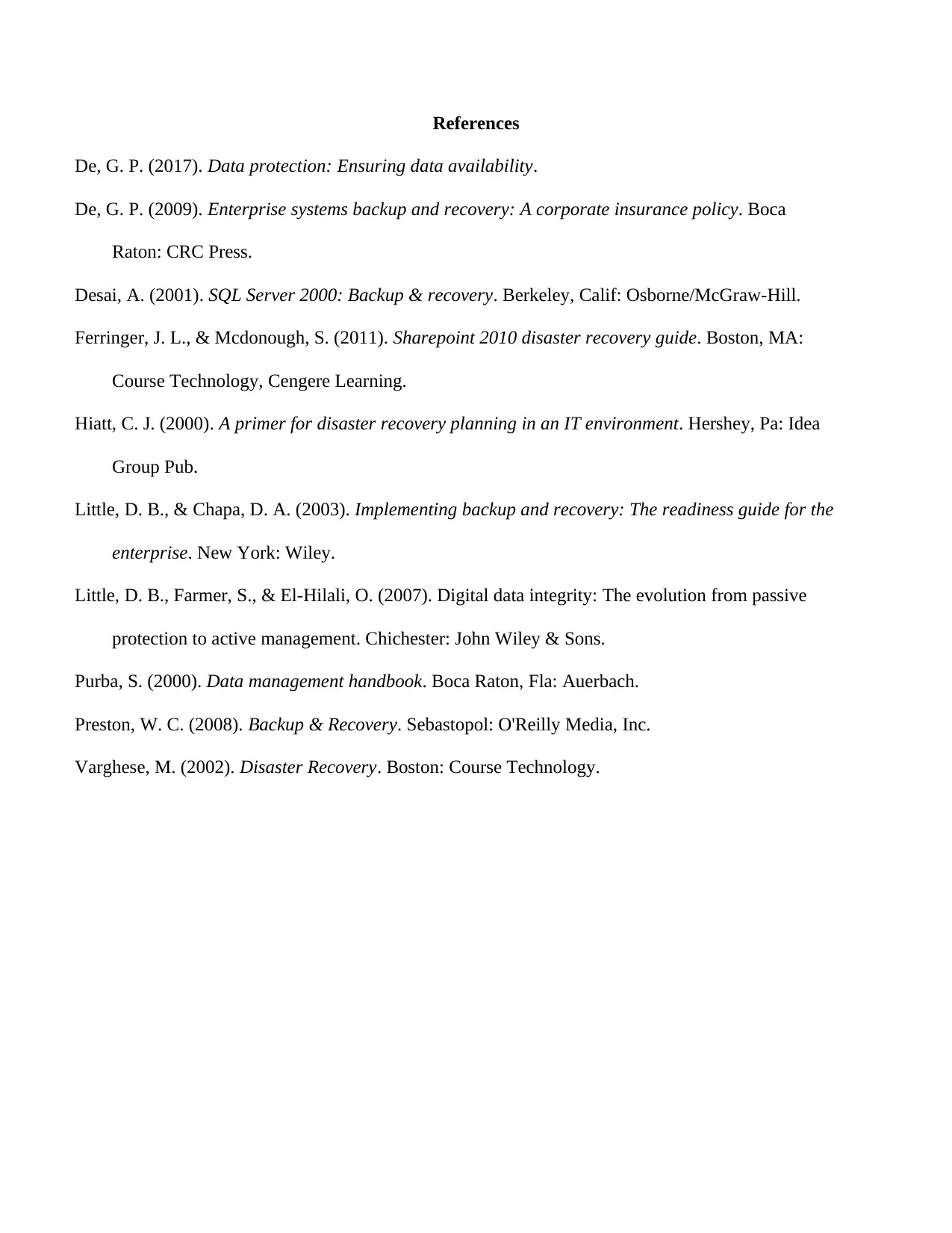
References
De, G. P. (2017). Data protection: Ensuring data availability.
De, G. P. (2009). Enterprise systems backup and recovery: A corporate insurance policy. Boca
Raton: CRC Press.
Desai, A. (2001). SQL Server 2000: Backup & recovery. Berkeley, Calif: Osborne/McGraw-Hill.
Ferringer, J. L., & Mcdonough, S. (2011). Sharepoint 2010 disaster recovery guide. Boston, MA:
Course Technology, Cengere Learning.
Hiatt, C. J. (2000). A primer for disaster recovery planning in an IT environment. Hershey, Pa: Idea
Group Pub.
Little, D. B., & Chapa, D. A. (2003). Implementing backup and recovery: The readiness guide for the
enterprise. New York: Wiley.
Little, D. B., Farmer, S., & El-Hilali, O. (2007). Digital data integrity: The evolution from passive
protection to active management. Chichester: John Wiley & Sons.
Purba, S. (2000). Data management handbook. Boca Raton, Fla: Auerbach.
Preston, W. C. (2008). Backup & Recovery. Sebastopol: O'Reilly Media, Inc.
Varghese, M. (2002). Disaster Recovery. Boston: Course Technology.
De, G. P. (2017). Data protection: Ensuring data availability.
De, G. P. (2009). Enterprise systems backup and recovery: A corporate insurance policy. Boca
Raton: CRC Press.
Desai, A. (2001). SQL Server 2000: Backup & recovery. Berkeley, Calif: Osborne/McGraw-Hill.
Ferringer, J. L., & Mcdonough, S. (2011). Sharepoint 2010 disaster recovery guide. Boston, MA:
Course Technology, Cengere Learning.
Hiatt, C. J. (2000). A primer for disaster recovery planning in an IT environment. Hershey, Pa: Idea
Group Pub.
Little, D. B., & Chapa, D. A. (2003). Implementing backup and recovery: The readiness guide for the
enterprise. New York: Wiley.
Little, D. B., Farmer, S., & El-Hilali, O. (2007). Digital data integrity: The evolution from passive
protection to active management. Chichester: John Wiley & Sons.
Purba, S. (2000). Data management handbook. Boca Raton, Fla: Auerbach.
Preston, W. C. (2008). Backup & Recovery. Sebastopol: O'Reilly Media, Inc.
Varghese, M. (2002). Disaster Recovery. Boston: Course Technology.
⊘ This is a preview!⊘
Do you want full access?
Subscribe today to unlock all pages.

Trusted by 1+ million students worldwide
1 out of 9
Related Documents
Your All-in-One AI-Powered Toolkit for Academic Success.
+13062052269
info@desklib.com
Available 24*7 on WhatsApp / Email
![[object Object]](/_next/static/media/star-bottom.7253800d.svg)
Unlock your academic potential
Copyright © 2020–2025 A2Z Services. All Rights Reserved. Developed and managed by ZUCOL.



